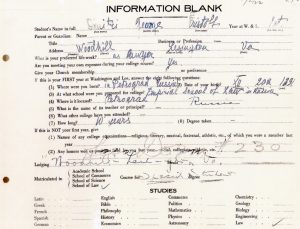

Above, Prince Dimitri George Sidamon-Eristoff as a second year law student at Washington and Lee University in 1924. On the right is the registration information from Sidamon-Eristoff’s first year of law school.
The year 1922 brought royalty to the Washington and Lee University School of Law student body in the person of Georgian Prince Dimitri Sidamon-Eristoff. Charles Moser, who was United States Consul to several countries, including Georgia, and who had “special detail” at Constantinople, arranged for visas for 3 Georgian princes (Simon, Dimitri, and Pierre) to travel to the US in 1921. Moser would also provide passage for Dimitri’s sister Xenia and her mother to come the US. Moser married Xenia in 1923. Moser already owned a house in Lexington, and they lived there. He suggested to Dimitri that he study law at W&L. Dimitri had extensive law training in St. Petersburg and spoke English well.
A “Russian Student Fund” (RSF) was set up by several wealthy Americans and the Russian Provisional Government’s Ambassador to the US, Bakhmeteff, to help White Russian emigres get a quality education with an eye toward creating better US-Russian relations if the Bolsheviks regime would collapse. The RSF encouraged a number of United States universities and colleges to offer scholarships to the most promising emigres, supplemented by funds from the RSF. Dimitri and Simon, (and perhaps Pierre as well) were among the first recipients of those scholarships.
Sidamon-Eristoff was a member of Phi Beta Kappa when he graduated with a Bachelor of Law degree in 1925. On February 20, 1926, he delivered an address in New York City to the American Foreign Law Association on the workings of Soviet law. It was published as Principles of Russian Soviet Law.
He practiced law for many years in Brooklyn, NY. On his death, his son George (B.A. Washington and Lee 1953) wrote, ‘I regret to inform you that “The Prince,” known as “The Iron Man” to some, passed away Oct. 22nd, 1969. He had a long and good life. And while every man has his regrets, he, perhaps, had fewer than most.’